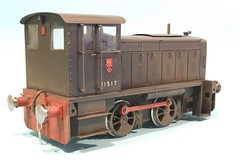In Gauge 1, even a small loco like this one is a big item to paint. The easiest way to get a overall coat of dirt is to use the airbrush. Some well thinned dark grey followed by dark brown all over the loco made the black paint look a lot better as well as providing a unifying effect to the previous work. Dark earth sprayed below the footplate replicates the sort of muck thrown up from the ground. Weathered black and even some matt black run along the top gives the effect of those mucky diesel fumes landing.
That super gearbox made once aspect of the job easier - the wheels can be rotated without power so I avoided "shadows" that can be left behind spokes and rods after spraying.
Once everything was dry, the glazing went in, roof on and the buffers were fitted. Then the wheels were cleaned and model packed up for delivery.
 On the layout, a little more commissioning work was required. Rich added the appropriate DCC decoder. The pickups needed a bit of tweaking and some weight adding. Although the kit makes up fairly heavy, there is lots of space for lead in the bonnet and if your wagons are heavy then the loco needs to do a bit more damage to the scales so it can move them !
On the layout, a little more commissioning work was required. Rich added the appropriate DCC decoder. The pickups needed a bit of tweaking and some weight adding. Although the kit makes up fairly heavy, there is lots of space for lead in the bonnet and if your wagons are heavy then the loco needs to do a bit more damage to the scales so it can move them !However in it's new colliery home, the model looks smashing. OK, so it needed a bit more work than simply assembling the kit to produce this particular prototype but it's well worth it.

No comments:
Post a Comment